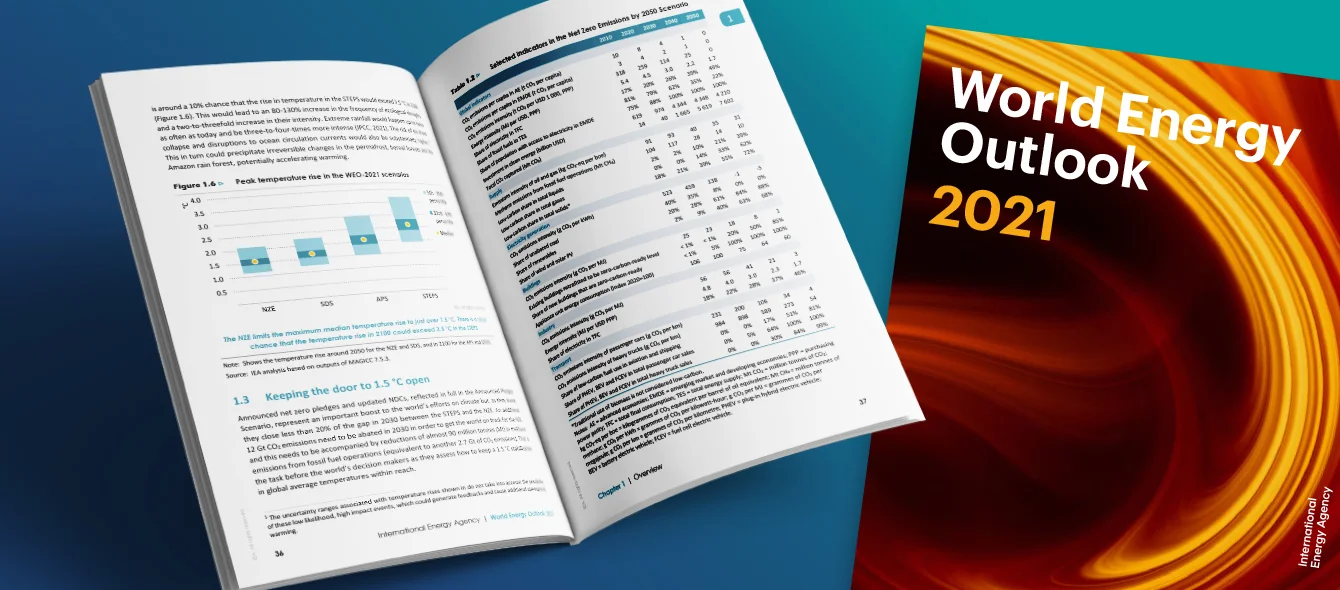Many observers and policy makers look to the International Energy Agency’s (IEA) World Energy Outlook 2021 (WEO), published in October, as a guide both to understanding the current situation and for future policy action.
The WEO, first published in 1977, provides long-term forecasts for the energy sector. It has evolved substantially over time, from a primary focus on supply security and fossil fuels, to address the new challenges presented by climate change.
These, according to the IEA, herald a new era in which electricity becomes the dominant form of energy delivery, generated by clean renewable energy sources, predominantly wind and solar power.
The WEO is split into scenarios, which reflect the world’s current trajectory, a pathway based on the implementation of declared new policies, one based on the pledges made by governments, and the IEA’s Net Zero Emissions by 2050 scenario (NZE), published in May, which shows what needs to be done to limit the rise in global temperatures to 1.5°C above pre-industrial levels.
Implementation gap
The business-as-usual scenario, today, is barely worth consideration – radical action is needed to address climate change.
But there are still big gaps between stated policies, pledges and what is needed to achieve a stabilisation of global temperatures, the IEA says.
In its Announced Pledges Scenario (APS), the WEO portrays a huge amount of energy transition success. Annual additions of wind and solar power approach 500 GW a year by 2030, oil demand peaks as early as 2025, coal use falls 20% by 2030 from recent highs and global energy-related CO2 emissions fall by 40% over the period to 2050.
However, the IEA points out critical caveats:
- all announced pledges must be successfully implemented, which can by no means be taken for granted;
- under the APS, by 2100, global temperatures will still exceed the goals of the Paris Treaty on Climate Change, rising by 2.1°C above pre-industrial levels; and
- temperatures do not stabilise because the world does not reach zero net emissions.
Moreover, in its Stated Policies Scenario (STEPS), the IEA explores the difference between pledges and policies, and the gap is worrying.
In this scenario, huge emissions reductions in the power sector are offset by increases from industry, rising energy demand and still relatively carbon-intensive economic development. Annual greenhouse gas emissions in 2050 are about the same as now, global temperatures increase by 2.6°C by 2100 and remain on an upward trend.
And if the gap between policies is large in comparison with pledges made, it is larger still when compared with a global pathway consistent with limiting temperature rises to 1.5°C – the NZE.
New initiatives essential
The IEA says: “Today’s pledges cover less than 20% of the gap in emissions reductions that need to be closed by 2030 to keep a 1.5°C path within reach.”
A key reason for this are the large differences in the speeds of many countries’ energy transitions, which in part reflect differing financial and technical abilities. The IEA emphasises the global nature of the challenge, arguing for a “collaborative global transition in which no one is left behind.”
Highlighting that today many climate change solutions are cost effective, the IEA puts forward four key measures to close the gap between current policies and pledges on the one hand and what is needed to stabilise rising temperatures by 2050 on the other.
- a massive additional push for clean electrification;
- a relentless focus on energy efficiency;
- a broad drive to cut methane emissions from fossil fuel operations; and
- a big boost for clean energy innovation.
Underlying this is the need to mobilise public and private capital in pursuit of environmental objectives. Getting on track requires a surge in annual investment in clean energy projects and infrastructure to nearly $4 trillion by 2030, some 70% of which is needed in developing economies, the agency estimates.
The IEA says the costs of inaction are “immense” but the opportunities for clean economic development are huge. Countries can take advantage, today, of wind, solar and other forms of renewable energy to develop and deploy the sustainable energy systems of tomorrow, but this effort needs to be collaborative to ensure global success and avoid competitive tensions between countries as the energy transition progresses.
